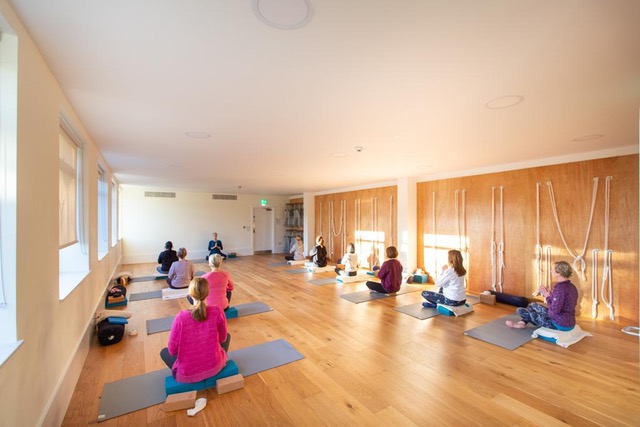Modern day yoga means many different things to many different people. Originating in ancient India, yoga encompasses physical, mental and spiritual disciplines. It promotes flexibility, strength and mindfulness, while improving the overall well-being of those who practice it.
When considering the origins of yoga, it’s important to look at B.K.S. Iyengar, the namesake of our particular discipline of yoga, and the man who was largely responsible for bringing yoga from India to the rest of the world. Iyengar yoga is the most practised form of yoga in the world and what stands it apart from other disciplines is the use of props to enable, with careful guidance, everyone to access the benefits of yoga.
So what does ‘yoga’ actually mean?
If you were to try and define yoga with some single, cohesive definition, you would certainly struggle. Over 5,000 years of practice have made yoga a multi-faceted system that is only one of the six systems of Indian philosophy. It thus has a multitude of definitions and meanings, that shift depending on the perspective from which it’s being defined.
“Yoga teaches us to cure what need not be endured, and endure what cannot be cured.”
B. K. S. Iyengar
But, we can look to a definition of the word itself. “Yoga” or it’s root, literally means to yoke or bind together. When we consider how and why we undertake the practice of yoga, in a sense, we “yoke” or harness our attention and consciousness in order to reach some level of physical, emotional liberation.
Generally, interpretations of the term seem largely to agree that yoga is the path to samadhi, which can be loosely translated as ecstasy, the ecstatic state, liberation, super consciousness, or ultimate reality. The ecstatic state that is samadhi is a state of consciousness where there is union between the body and its spirit.
That’s a key point of yoga, its effects are not merely limited to our physical form. It encourages thought not only of the body but of the mind as well, emphasising self-knowledge. To practice yoga is to aim for an understanding of the ephemeral nature of our existence, and achieve a state of consciousness where we can appreciate that happiness and satisfaction are not linked to acquisitions or physical sensations, rather, they are linked to a mastery of the mind.
This control of our consciousness is the path of yoga, and this quest for self-knowledge and equanimity is why yoga as still as relevant today as it has ever been.
Where did yoga originate?
Yoga’s history reaches back over 5,000 years into the ancient sages and civilisations of India. It is in particular rooted in the ancient literature of Hinduism. As you’d expect, there are an enormous body of teachings, spiritual values, attitudes and concepts across philosophy and religions that marry together to create what we understand as yoga.
Yoga’s earliest and most treasured texts are the Vedas, which were actually a form of hymn. Written in the language Sanskrit, they contain knowledge of the ancient Vedic civilisation, and date back to somewhere between 4500 and 2500 BCE.
These texts include the ancient rites and practices undertaken by the Vedic priests, as well as the rigorous mental training which they required to perform their duties as part of that revered civilisation. The charting of these mental disciplines was then the foundation of the Upanishads, which were written some two thousand years later, and proposed that meditation could be the path to enlightenment.
After this, came the ‘pre-classical’ era – the era of the Sutras and Shastras and the earliest complete yoga work, known as the Mahabharata in which the Bhagavad-Gita is contained.
The Yoga Sutras of Patanjali, probably yoga’s most famous texts, were written in the ‘classical’ era of 100-50 BCE, and were a systematic compilation of the writings and thinking up until that point. Patanjali gave yoga its classic format. The Sutras defined and regularised the key elements of yoga theory and practice. Using 195 Sutras, Patanjali gave yoga what has become its modern form.
Sutras, which translates roughly to ‘threads’, are short, pithy phrases of Sanskrit which are a form of aide memoire, to be used by a student alongside a teacher or guide, who has existing knowledge of the subject.
Years later, in the medieval period, we find the writings of the Hatha yoga Pradipika, bringing us into the ‘common’ era. Whilst Patanjali focused on achieving control of the mind and gave us an outline of the path of yoga, the Hatha Yoga Pradipika provides a clearer explanation of the physical requirements of yoga. Across its four chapters, the text details a number of asanas and breathing practices, many of which we would recognise from our own, current practice of yoga.
How has yoga developed to what we know today?
From the medieval period, the physical pursuits of Hatha yoga have been practiced by a minority which had been further squeezed by the British colonial rule in India at the time, and fears of “fringe” tendencies.
However, with push back against colonialism and the subsequent rise of Indian nationalism, Hatha yoga found a new (albeit small) audience.
Against this backdrop, Krishnamcharya enters the picture. After many years of studying Sanskrit and the ancient texts and learnings with his Guru, Brahmachari, Krishnamacharya was invited to teach the sons of a royal household in Mysore.
Under this royal patronage, he was able to study and develop a lot of what we recognise today as the physical aspects of yoga. Focusing on the bodily aspects of Hatha yoga, he adapted the system and drew inspiration from both wrestling and gymnastics to develop dynamic asana sequences with the purpose of building physical fitness.
In addition to the royal household, Krishnamacharya took on other students, of whom three in particular were to raise the profile of yoga far beyond the borders of India. Amongst these, was Pattabi Jois, who, through his studies, further developed Ashtanga Vinyasa yoga.
Originally designed for young, strong men, it gained traction more widely, as a sort of gateway to the more philosophical and spiritual aspects of yoga.
Indra Devi was another alumni, having received instruction from Krishnamacharya, she travelled to China, the Soviet Union, and America, teaching and proselytising yoga, as well as setting up dedicated schools.
However, most prominently, B. K. S. Iyengar studied with Krishnamacharya. Having been a sickly child and failed in academic study, he was sent by his family to live with his sister and brother-in-law. After showing promise, he was subject to a rigorous and sometimes harsh training regime under Krishnamacharya. After which, he was encouraged to go out and spread the word of yoga.
Moving with his wife, Ramamani, to Pune, Iyengar started to work with students who were not as young or as fit as the royal princes in Mysore. So he began to study the poses in enormous detail, and adapt them with use of props, to open up yoga to all.
This precise study of the asanas and their therapeutic benefits by Iyengar was captured for the world in his seminal book “Light on Yoga” which was published in 1966.
Now considered somewhat of a bible within the yoga community, it was his association with Yehudi Menuhin, a world-famous violinist, and their foreword in the book which helped propel Iyengar yoga initially to the West, and then around the world.
This, together with a rigorous and comprehensive teaching training programme created by Iyengar, ensured that attention to detail, precision and focus on alignment are the gold-standards of modern yoga and its teaching.
Because of this commitment, Iyengar yoga continues to flourish in the 21st Century under the care of Iyengar’s grand-daughter, Abhijata.

